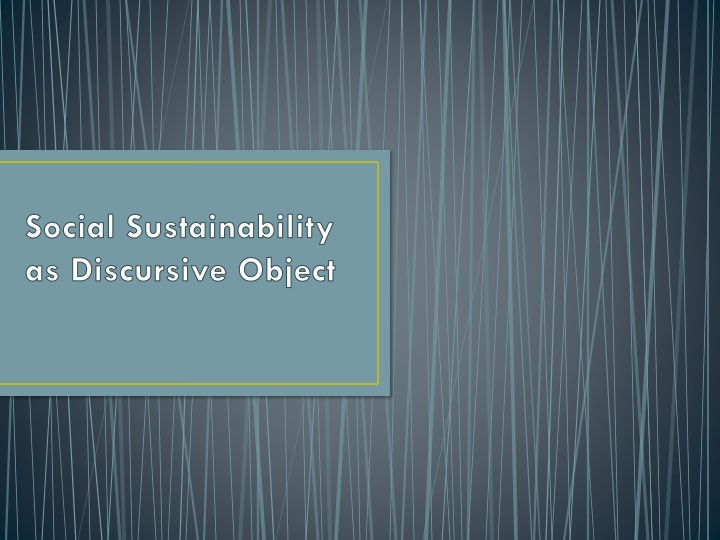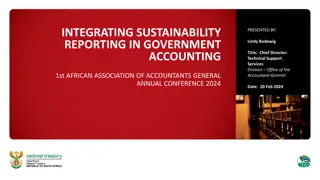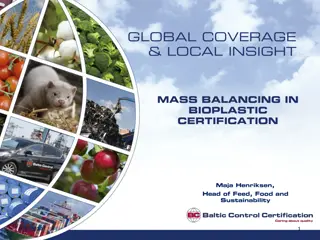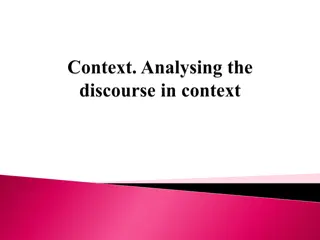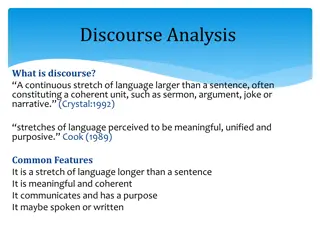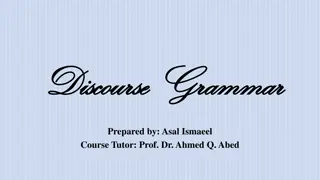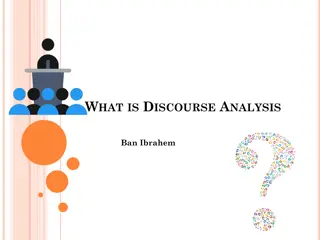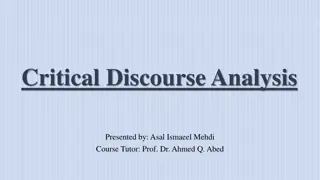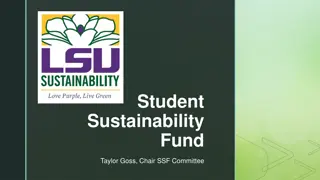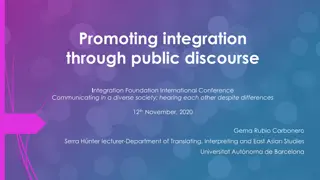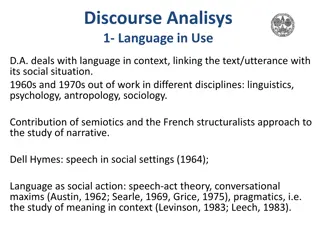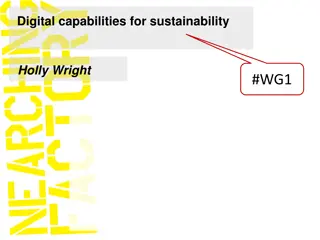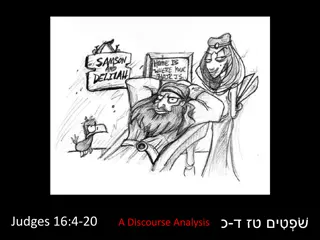Social Sustainability Discourse Analysis
Discourse analysis of social sustainability as a discursive object, focusing on data collection, word frequency, keyness analysis, and thematic domains. The analysis compares the INSS corpus to the COCA corpus, highlighting key words and thematic references related to community, neighborhood, city, and urban settings. Gain insights into the semantic salience and critical themes in discussions on social sustainability.
Download Presentation

Please find below an Image/Link to download the presentation.
The content on the website is provided AS IS for your information and personal use only. It may not be sold, licensed, or shared on other websites without obtaining consent from the author.If you encounter any issues during the download, it is possible that the publisher has removed the file from their server.
You are allowed to download the files provided on this website for personal or commercial use, subject to the condition that they are used lawfully. All files are the property of their respective owners.
The content on the website is provided AS IS for your information and personal use only. It may not be sold, licensed, or shared on other websites without obtaining consent from the author.
E N D
Presentation Transcript
Social Sustainability as Discursive Object
Data Collection and Analysis Discourse Corpus based on May 2013, Year 1 Conference Corpus data: Plenary presentations 11 Small group discussions, both Day 1 and Day 2 Talk was video-taped and transcribed Corpus: 136, 541 words
Word Frequency and Keyness Frequency raw frequencies of particular word types in a discourse suggest topical salience. Keyness or Key words words that have a statistically significant higher or lower frequency of occurrence in a discourse compared to what one would expect. *Comparison between focus corpus and normed reference text The higher the keyness value, the greater the semantic salience in a given corpus. High keyness values provide a reliable indicator of what a discourse is about.
Frequency and Keyness Analysis: Comparison of INSS corpus to COCA corpus INSS Corpus: 136, 541 words Corpus of American Contemporary English (COCA) 100,000 word list. Largest, carefully- corrected, frequency-based word list of English (Davies 2010). http://www.wordfrequency.info/100k.asp Corpus analysis used AntConc software (Anthony 2011) Keyness values log-likelihood test to compare frequency of words in INSS corpus to COCA
Unsurprising high frequency and extremely robust keyness values Keyness value 7798.9 Raw Word type frequency 690 Sustainability Sustainable 157 1056.0 Social 689 2417.5 Society 83 86.5 Socially 30 107.4 People 555 310.4
Frequency and Keyness Thematic Domains: Location/Site Frequent references to community and neighborhood as sites for social sustainability. These are metaphoric, ambiguous. Location/Site/ Group Raw Frequency in INSS Corpus Keyness re. COCA Community 178 273.3 Communities 73 172.4 Neighborhood 22 13.2 Neighborhoods 14 19.9
Frequency and Keyness Thematic Domains: Location/Site Frequent reference to city/urban suggests an urban bias in terms of sites for social sustainability. Location/Site/Group Raw Frequency in INSS Corpus Keyness re. COCA City 90 12.7 Cities 40 55.1 Urban 63 144.3 Village 3 5.6 Town 15 0.09 Rural 12 40
Frequency and Keyness Thematic Domains: Topical Related to Grid/Sector domains Topic Raw Frequency in INSS Corpus Keyness re. COCA Environment 56 67.2 Environmental 144 359.3 Ecology 8 14.9 Ecological 15 30.7 Economy 24 0.8 Economic 79 53.3 Economics 17 27.7
Frequency and Keyness Thematic Domains: Topical Related to Grid/Sector domains Location/Site/Grou p Raw Frequency in INSS Corpus Keyness re. COCA Energy 41 12.9 Transportation 40 96.8 Mobility 8 13.9 Water 128 70.3 Food 56 13.6
Frequency and Keyness Thematic Domains: Topical Related to Grid/Sector domains Topic Raw Frequency in INSS Corpus Keyness re. COCA Education 77 24.6 Educating 4 6.87 School 56 10.2 Culture 29 4.8 Cultural 50 49.2 Safety 26 12.0 Security 7 22.3 Shelter 1 0.02 Housing 5 0.9
Discourse on social sustainability: Thematic salience The sectors introduced in the grid are strongly salient in the discourse Particularly salient are environment transportation water economic culture
Frequency and Keyness Thematic Domains: Topical Related to Human Values Location/Site/Grou p Raw Frequency in INSS Corpus Keyness re. COCA Needs 74 62.3 Justice 30 11.8 Equity 17 38.9 Equality 4 1.7 Equitable 7 23.3 Empower 8 30.1 Empowering 6 21.1 Ethics 11 10.7 Rights (human/gender) 10 7.85
Frequency and Keyness Thematic Domains: Topical Related to Human Values Location/Site/Grou p Raw Frequency in INSS Corpus Keyness re. COCA Quality of life 29 -- NA Well being 35 -- NA Spiritual 8 0.7 Religious 8 4.5 Adaptive 17 17.4 Resilience 12 47.8 Hope 14 -- NA Flourishing 3 7.37 Vibrance 4 16.2
Collocations with Sustainability Collocates in Range 10 words to Left and 10 to Right of sustainability Frequency Mutual Information Value -measures probability of two words occurring close to each other in a discourse Social 470 7.08 Characterizing 18 7.47 Institutional 11 6.67 Temporal 10 6.42 Definition 49 6.47 Term 20 6.37 Define 15 6.25 Cultural 19 6.23 Socially 12 5.78 Environmental 40 5.78
Collocates in Range 10 words to Left and 10 to Right of sustainability Frequency Mutual Information Value -measures probability of two words occurring close to each other in a discourse Tools 15 5.60 Assessment 10 5.52 Economic 18 5.49 Engineering 17 5.45 Communities 12 5.02 Community 26 4.85
Collocations with sustainability In this discourse, talk about the activity of defining social sustainability was particularly salient (characterizing, definition, term, define). The need for assessment tools was strongly associated with this keyword. Thematic values institutional, temporal, cultural, environmental , economic, engineering had high likelihood of co-occurring with sustainability. The quality-of-life and justice and equity values were not frequent collocates with sustainability.
Conclusion The corpus analysis suggests A bias to urban sites in the discourse A frequent orientation to useful but ambiguous terms such as communities or community as sites for action. A strong orientation to environmental concerns in the discourse. Human values of well being, spirituality and justice and equity are emphasized but these need further unpacking.
Conclusion The first conference established the groundwork and oriented members to a common goal. This second conference can build upon the work of the first as members again work to construct social sustainability as a coherent discursive object, which can serve as resource for action.
